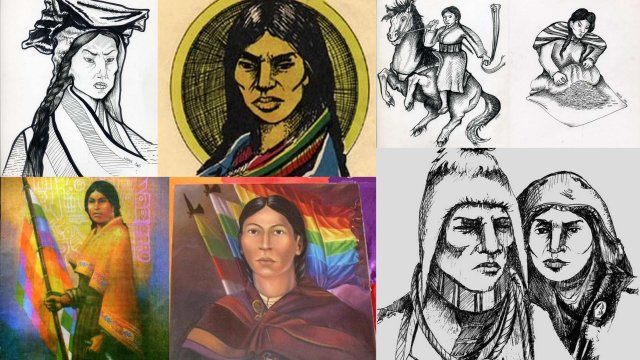
At the Second Meeting of American Organisations and Movements in Tihuanacu, Bolivia, in 1983, September 5 was officially designated International Indigenous Women’s Day.
Since then, September 5 has been growing in recognition as a major event in Latin America's progressive calendar.
The date was chosen in honour of Bartolina Sisa, an Aymara resistance leader who was brutally executed by royalist forces in La Paz, now the capital of Bolivia, on September 5, 1782.
During the early 1780s, the highlands of Peru and Alto Peru (present-day Bolivia) were convulsed by rebellion as armed Quechua and Aymara groups challenged their colonial oppressors.
After centuries of mistreatment, tensions were greatly worsened by harsh new taxes. These left indigenous peoples with almost nothing to live on and a forced labour regime that amounted to slavery.
The popular uprisings led by Tupac Amaru II and Tupac Catari (Bartolina Sisa’s husband) were revolutionary in purpose, with many similarities to the goals of present-day social movements.
Together they defied the imperial system, seeking a restoration of indigenous rights and a more equitable redistribution of the Andean region’s abundant natural resources.
It was in Chayanta province, home to the silver mines of Potosi where millions of indigenous slaves had died extracting the precious metal for the Spanish, that the Catari rebellion began.
The movement spread. One by one, the highland towns fell to the rebels, whose ranks quickly swelled to more than 40,000.

From the start, Bartolina made a dynamic contribution to the movement, ensuring the concerns of women were addressed in revolutionary councils.
She was also a charismatic general in her own right, possessing inexhaustible reserves of mental strength and resolve. In May, 1781, during the siege of La Paz, she personally led an action that drove attacking royalist forces back into the city.
Bartolina intervened decisively in many other crises, inspiring thousands of men and women under her command to continue the fight.
Ultimately, however, the siege of La Paz failed when the royalist garrison received reinforcements despatched from as far away as Lima and Buenos Aires.
Sallying forth from the city, the imperial troops conducted a series of savage reprisals. They burned villages and massacred men, women and children.
During the Catarist retreat in the latter half of 1781, the selfless Bartolina Sisa, indomitable defender of her oppressed people, was betrayed and handed over to the royalists.
They imprisoned her in a dark La Paz dungeon, subjecting her to months of sadistic torture and rape. They kept her alive only to serve as bait in the capture of Tupac Catari.
Both Amaru and Catari were ultimately apprehended and executed by the vengeful empire in 1781.
Their tongues were cut out and bodies torn apart by horses in the town squares of Cusco and La Paz respectively.
Their body parts were displayed throughout the land as a warning to other troublesome natives.
The same fate was reserved for Bartolina, who was taken from her cell and dragged with a rope around her neck to the same plaza in La Paz where her husband had been murdered.
Shouts of abuse and a rain of stones accompanied her final moments as she was exhibited naked and bleeding but still defiant.
After being strangled along with her sister-in-law Gregoria Apaza (another notable rebel commander), her hands and head were severed for public display.
Bartolina’s fate has never been forgotten by the Aymara women of Bolivia, who preserved the memory of her struggle and sacrifice. She is also revered in indigenous communities of Peru, Chile, Venezuela and other Latin American nations.
September 5 is a day not only to remember Bartolina Sisa, but the indispensable role played by generations of indigenous women most of whose names have been lost to history in the 500-year struggle for decolonisation, land reform and social justice.
Bolivian President Evo Morales the Andean nation's first indigenous head of state paid tribute to Bartolina in La Paz on September 5. “This homage,” he said, “is an act of great importance to refresh the memory, to speak the truth about great uprisings in our territory and the liberation of peoples”.
Under the oppressive rule of Bolivia’s former oligarchy, Morales said, the contribution of indigenous leaders like Bartolina “went unrecognised and unrecorded in national [official] history”.
What Bartolina bequeathed to later generations, however, was “the inheritance of struggle for social, cultural and economic liberation”.
In accordance with her status as an important symbol of “admiration and respect”, Morales announced that La Paz’s main square, the Plaza Mayor/Plaza Murillo where Bartolina was put to death in 1782, will now be known as the La Plaza Bartolina Sisa.
The renaming of an important public space in the administrative heart of La Paz in honour of Sisa affirms the progressive tendencies of the democratically-elected Morales administration.
As in Venezuela and Cuba, the struggle for women’s rights has been a focus of attention in revolutionary Bolivia.
Such a development the result of a proposal put forward by an indigenous women’s organisation representing communities across Bolivia would have been unthinkable under the old neoliberal regime that preceded Morales, and whose agents still resist the struggle for change.